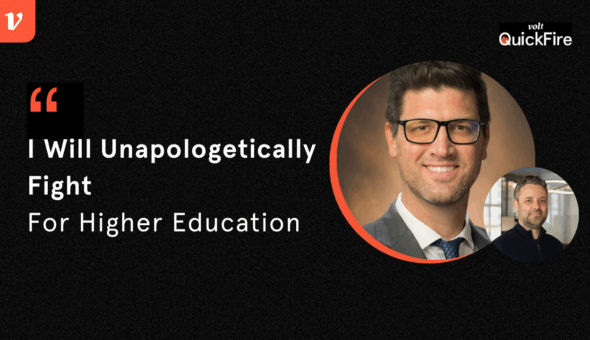College visits by prospective college students were already declining before COVID; a year of travel restrictions has made the practice seem borderline antiquated. Whether or not it rebounds, the pivotal role of virtual experiences in college recruitment is almost certainly here to stay.
That puts smaller schools, who have long relied on the charms of their physical campuses and student hosts to make them memorable, at a disadvantage. If fewer and fewer students visit campus and students are simultaneously finding new ways to explore the environment from afar, how can we communicate our ‘unmatched traditions,’ our ‘tight-knit community,’ and – most importantly – how can students experience and understand those intangible elements of our school that looks very much like quite a few other schools in the pictures?
Patagonia might have an answer.
Patagonia’s “Worn Wear” Initiative
Patagonia has a history of using activism to help their position in a highly competitive category. Their “Worn Wear” initiative that has been running for nearly a decade is a staple brand activation upon that key piece of the brand’s identity, with its glorification (and amplification) of repaired and upcycled Patagonia items. Patagonia has used brand communications, user-generated content and creator partnerships to elevate and grow the brand’s loyal community while strengthening their brand’s identification with the idea of durability.
Read more: The almost-impossible task of differentiating your school
While “Worn Wear” is part of a much larger campaign, and a highly popular global brand, it also shows how institutions can extend what drives ‘fit’ on their campuses into digital spaces. The key is to uncover how you talk about place to establish fit. Use the markers of brand community to dig deep into the words you use to bring them to life, noting the mandatories your communications must have to achieve it. Align those mandatories with the best channels and develop a plan for content that’s either from the brand or from your community. Use tags, hashtag and location data to find the strongest user-generated content, and any creators who might form a valuable partnership. Finally, decide how content should be distributed.
In short, think about and activate your brand less as a higher ed brand and more like a consumer brand a la Patagonia; but before you can do that, you must also recognize and address the ways in which any institution of higher education is, almost by definition, a service brand.
Higher Ed Brands as a Service Brand
For schools concerned about losing impactful points of differentiation, using the tenants of service-based brands to strengthen how important components of community – both interactions with people and place – can be delivered in a way that strategically reinforces those key differentiators. In a sense, developing a framework for defining and delivering on ‘place’ or ‘fit,’ no matter the touchpoint.
Service-based brands are built through the consumer’s various points of contact with company employees and community (both physical and digital). From pre-purchase experience to post-purchase evaluation, each touchpoint throughout each stage – when strategically managed – combines to strengthen the perceptions of a brand.
Read more: How Clemson University uses TikTok
The same can be said for higher education brands: The customer-brand experience is centered around employee and campus engagement. This places an emphasis on the many interactions between prospective students and admissions staff, college or school representatives, faculty and current students as well as the campus environment as being the primary drivers of ‘feel.’ When these integral points of differentiation are removed from the prospective student journey, prospective students must find new ways to establish fit – in most cases turning to the web and social media.
So while looking at higher education brands as service-based brands gives us a sense of what should be managed and why, the markers of brand community – more often associated with consumer brands – will help us better define and communicate what we mean by words like ‘tight-knit community’ or ‘unmatched traditions.’
Brand Community and Higher Education
If we lose the ability for prospective students to physically experience our points of distinction, then we need to work out how to breathe life into them, because pounding our chest about our ‘vibrant community’ isn’t going to cut it. Uncovering uncommon ways to define what it is about our campus environment will open up possibilities, not only in our messaging, but in our creative briefs. Using the markers of brand community provides a compelling exercise in communications strategy.
In most cases, brand communities are built through the use of a product and add value beyond the product’s immediate use. Brand communities can develop organically – take Harley Davidson, for example – or they can be co-created, as in the case of Lego. Regardless of their creation, there are three distinct markers that most academics agree on.
- Shared Experience: Share experience comprises the social processes that generate meaning and is in turn reproduced within the community. For brands or institutions, these are consumption-related experiences reproduced and repeated within those who are actively engaged. Thematically, these types of experiences usually revolve around celebrating the history and traditions of the brand or sharing brand-related stories. In higher education, the trick is to develop words, phrases and feelings into messages that resonate beyond current students and are articulated in a way that supports your positioning. Think: What do your students share?
- Consciousness of Kind: Think of consciousness of kind as “we-ness.” Not only do members share a strong connection to the brand or institution, but more importantly, to each other. Like in our social communities, this link is more important than the brand, but it’s the brand which has brought the community together. Think: What draws students to your institution?
- Moral Responsibility: Moral responsibility is the sense of duty to the community and its members. This is what brings people together, creating collective action and contributing to group cohesion. It’s what keeps alumni engaged and new students integrated. This is often tied to a larger sense of responsibility, and if we are to believe that Gen Z is driven by purpose and the greater good then these stories should matter. For example, the story of the student chapter whose mission is to spread literacy in the community can speak to the collective.
These markers of brand community can be used to fully realize what creates a sense of place at your institution and bring clarity to how it should be communicated. By finding a deeper meaning, we can open up the typical words we use to truly mean something more and bring them to life across the spaces prospective students visit. As Patrick Hanlon argued in the Social Code, vibrant and desirable communities have a story that is relevant, resonant and makes those a part of the community feel that they mean something.
Putting it all Together: Co-Creating the Community Experience

Not only have digital platforms expanded prospective student experiences, but remix culture, consumer tools for creating content (think Canva and in-app video editing tools), and social networks that broadly amplify content have also created new ways to experience brands. In the case of higher ed brands, new avenues for prospective students to experience ‘fit’ have been created. Whether it’s through Reddit threads, college search sites, social media hashtags or location tags, students easily ping-pong from brand communications to user-generated content from peers. Many direct-to-consumer brands and fashion brands have taken note and leveraged this shift in brand experiences, activating co-creation efforts across marketing channels – maintaining consistency being the biggest challenge. For higher education marketers, maintaining consistency between brand communications and user-generated content is critical, especially for smaller schools with lack of market presence.
To get there, as you’ve uncovered the real meaning behind the more traditional descriptions of community, how it should be communicated should start to crystalize – creating meaning and mandatories for marketing deliverables. As it does, compile a list of those visual elements, locations, student stories, shots lists, etc. that come to light. This list will help to maintain consistency across communications, creators and channels.

The next step is to determine which messaging elements align with your marketing channels. Message and channel alignment are key to creating more impactful meaning. For example, if how you communicate ‘place’ requires more place-setting, channels that are more conducive to long-form video or an owned event/platform may be the better option. If you are connecting your institution to the surrounding city, a display ad would be an effective channel to create and reinforce the quick association.
As you indicate which of the channels will be most important to use, assess which should come from the brand – usually paid or organic – and which content should support the brand, created by users. And since you’ve already created marketing mandatories, selecting which user-generated content to repurpose or amplify should be easy.
Finally, plan how content should be distributed. If you are using user-generated content, you can either reshare or shape the content into ‘owned’ content to amplify it (like using a social post about your school that is not from an official partner in a promotional video). If you are developing a partnership with creators on your campus, you can create a partnership where they create content based on your mandatories and publish via their channels and your channels or publish content through creators – similar to an influencer model. In either case, the decision should strengthen the alignment between marketing mandatories and channels.
Conclusion
Higher education marketers are at an inflection point. COVID, new entrants to the market, and the drive to differentiate have spurred many institutions – especially smaller schools – to rethink their brand positioning. Like Patagonia, co-creating that position allows higher education marketers to harness the experiences (and audiences) of peers, establishing a new layer of trust and expanding the reach of your communications, all while articulating the distinct character of your school – especially for prospective students who may never set foot on your campus until the first day of classes.









